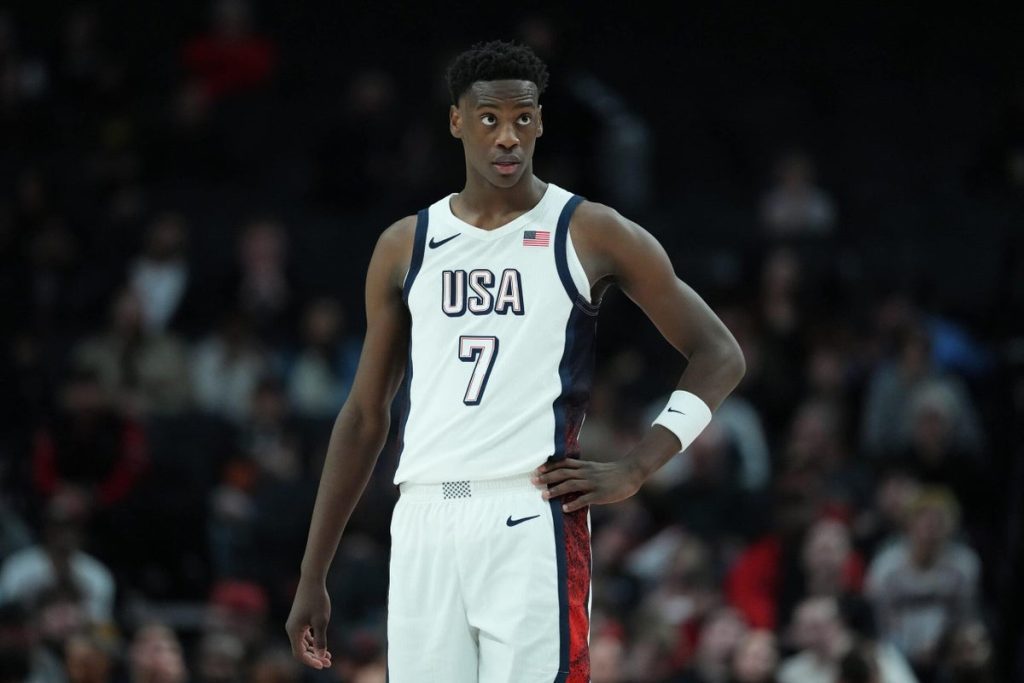Team USA headed into the FIBA U19 World Cup in Switzerland as the frontrunner for the gold medal, and they fulfilled expectations by triumphing with a commanding 109-76 victory against Germany, who had previously been undefeated, in the championship match. Freshman AJ Dybantsa, an incoming star for BYU, played a pivotal role in securing the title.
Dybantsa not only helped secure the gold medal but also earned MVP honors, averaging 14.3 points, 4.1 rebounds, 2.3 assists, and 1.1 steals during the tournament. Both teams entered the final with perfect 6-0 records, but the depth and talent of the American squad outshone the German team, which was spearheaded by Texas Tech’s standout freshman Christian Anderson Jr.
Dybantsa’s Distinctive Skills
Throughout the tournament, Dybantsa demonstrated why he is considered a top prospect, expected by many to be the first overall pick in the upcoming draft. His ability to influence both offense and defense significantly positions him as a potential two-way star. Although he struggled with three-point shooting (11.1%) in this tournament, playing in BYU’s offensive system should provide him with more open looks.
His playing style, which echoes that of NBA star Paul George, showcases his skill in making crucial plays and navigating to the basket for scoring or assisting. Dybantsa’s exceptional effort on the court is notable; it’s rare to see a player ranked this high work so diligently. He recorded at least one steal in every game except one, using his length and activity to trouble opponents consistently. — Tobias Bass, staff editor
The Talent of the 2026 NBA Draft Class
Dybantsa is among the top contenders for the No. 1 pick in the 2026 NBA Draft, which is shaping up to be highly competitive. The class includes several other strong prospects like Darryn Peterson (Kansas), Cameron Boozer (Duke), and Mikel Brown Jr. (Louisville). Many players improved their draft stock, including Brown, who made a significant impact during the World Cup.
Brown stood out by leading Team USA in scoring (14.9 points), assists (6.1), and efficiency, shooting 46/47/82, which has made him a serious candidate for the top pick. His skills as a lead guard will attract many NBA teams. Similarly, Anderson emerged as a potential candidate for Big 12 Player of the Year, averaging 17.3 points, 4.9 rebounds, and 6.6 assists throughout the tournament, showcasing impressive skills and drawing comparisons to NBA veteran Dennis Schröder. — Tobias Bass, staff editor
Future Olympic Aspirations for Dybantsa and Flagg
This tournament has sparked conversations about which players might represent the U.S. in future international competitions. After finishing fourth in this same tournament two years ago, Team USA’s dominating performance this year was a promising sign. Dybantsa has expressed his desire to compete for the U.S. team at the 2027 World Cup and possibly the 2028 Olympics, potentially alongside other young talents like Cooper Flagg.
Flagg, who was not part of the current team but previously excelled with the U17 squad, has made notable impressions in scrimmages against top NBA players. As both players continue to develop, their involvement in future Olympic rosters looks likely. — Joe Vardon, senior writer
Emerging Freshman Class in the Big 12
The 2025-26 season promises to be a landmark year for the Big 12, with an influx of talent among its freshman class. Ten of the top 24 prospects are set to join the conference. During Team USA’s title run, Koa Peat became the first player to win three World Cup titles in FIBA youth tournaments, showcasing his consistent performance with averages of 12.6 points and 6.9 rebounds.
The tournament also highlighted the depth of talent, featuring 54 college players and the increasing presence of international prospects. Teams like UConn and Washington are poised for success with promising young talent joining their rosters. — Tobias Bass, staff editor



